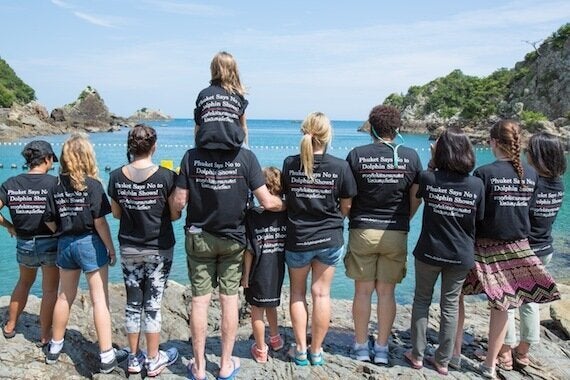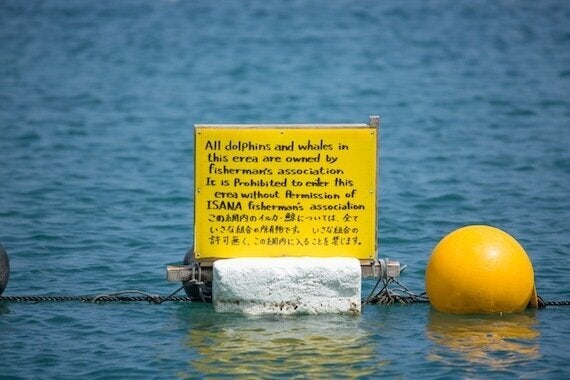
Phuket Says No To Dolphin Shows volunteers at Taiji Cove
Credit: Terran Vincent Baylor
Around 9.35am Japanese time on 11 September, a young Risso's dolphin is driven into and trapped in the cove. She slips under an enclosing net in an attempt to escape, but finds herself nearer to the shore instead of out to sea.
She lands at the feet of Ric O'Barry, star of the Academy Award-winning documentary The Cove and ex-dolphin trainer turned activist, who is helpless to intervene. Exhausted, she gives up the will to live, takes a final breath and sinks to the bottom of Taiji cove, never to be seen again.
This dolphin's death highlights the extreme cruelty of the drive process, but at least she is recognised. There are thousands of dolphins slaughtered each year, and the many more which are lost at sea or aborted through the stress of the drive remain unknown.
Taiji is one of the few places that capture and sell live dolphins into captivity. With more than 150 orders this season, an all-time high, Japan's Fisheries Cooperative stands to make millions of US dollars.
Taiji also slaughters dolphins for meat consumption, despite the flesh containing toxins such as mercury and PCBs. In this article published yesterday at The Japan Times, the Fisheries Cooperative admitted that local Taiji residents tested high for levels of mercury which can lead to chronic illness.
Terrified Dolphin Throws Himself At Ric O'Barry's Feet To Escape Hunters in Taiji, Japan www.DolphinProject.com @Dolphin_Project from Dolphin Project on Vimeo.
The Cove
The first time I watch The Cove I am sick to my stomach. Taiji is an irony. As it celebrates the history of whaling, the Taiji Whale Museum is the only facility where one can both watch dolphins while eating dolphin meat. It brokers many of the deals for the sale of dolphins, and the majority of its animals are sourced directly from the captures.
More than 40 dolphins in their 'collection' are held in shamefully small tanks and shallow sea pens. They float about listlessly, throw themselves onto the platforms repeatedly, and call out to visitors for attention, all unnatural behaviors resulting from stress and depression. Many die within a few years of captivity, but these dolphins are disposable and easily replaced.
Our trip to Taiji is a spur of the moment decision. With dolphins sourced from Taiji heading to Phuket, Phuket Says No To Dolphin Shows volunteers believe it is crucial that Thai residents and tourists from the UK and around the world are made aware of the exploitation of dolphins so we can help end this outdated practice. We decide to travel there on a personally funded trip for Japan Dolphins Day on 1 September, the first day of the drive hunt season.
Our impression of Wakayama Prefecture is that it is absolutely breathtaking, with abundant natural beauty and rich cultural heritage. It appears perfect, except for the dark secret in the small town of Taiji.
Cove Monitors in Taiji

Raising awareness to stop the dolphin slaughter in Taiji
Credit: Terran Vincent Baylor
Through Ric O'Barry's Dolphin Project, volunteer Cove Monitors document daily the drive hunts in Taiji. Their work provides vital third-party information on, and without it no one would ever know about Taiji and what goes on there.
As foreigners in Taiji, and especially being there with Ric O'Barry's Dolphin Project, the local police, state police, and even riot police closely watch us. Taiji has adapted and changed with the presence of outside observers. More than a dozen surveillance cameras have been installed around Taiji town. Any infraction means trouble and immediate arrest.
Everyday at 5am we arrive at Taiji Harbour to document the boats leaving the harbour for the drive hunt. Later at Tomyozaki lookout point - the tip of Taiji village, we scan the horizon to determine if they are in drive formation.
If the boats locate a pod of dolphins, we head directly to the cove to film and livestream the process. We are fortunate enough not to have witnessed a single slaughter of dolphins while in Taiji, but the constant harassment we receive reminds us every minute that Taiji has something to hide.

Handwritten signage on a net in the middle of Taiji Cove
Credit: Terran Vincent Baylor
Intelligent and self-aware, dolphins suffer emotional and physical pain. Ripped from their families, they remember and mourn. The Whale Museum often chooses young, reproductive females and their offspring, or juvenile dolphins. The remaining pod - if released, consists of elderly dolphins or males. Many suffer shock from the drive process and can die days or weeks later.
Taiji leaves a heavy feeling, but one we need to experience. We return to Thailand equipped with extensive knowledge to share. Phuket Says No to Dolphin Shows is a group of volunteers working toward keeping dolphins out of tanks in Thailand and free in the ocean. Our journey is only beginning.
The one message we want everyone to walk away with is this: The single most effective action that anyone can take to help Taiji dolphins is never buy a ticket to a dolphin show anywhere.
Take the pledge to not support dolphin shows and the needless cruelty in Japan now.
